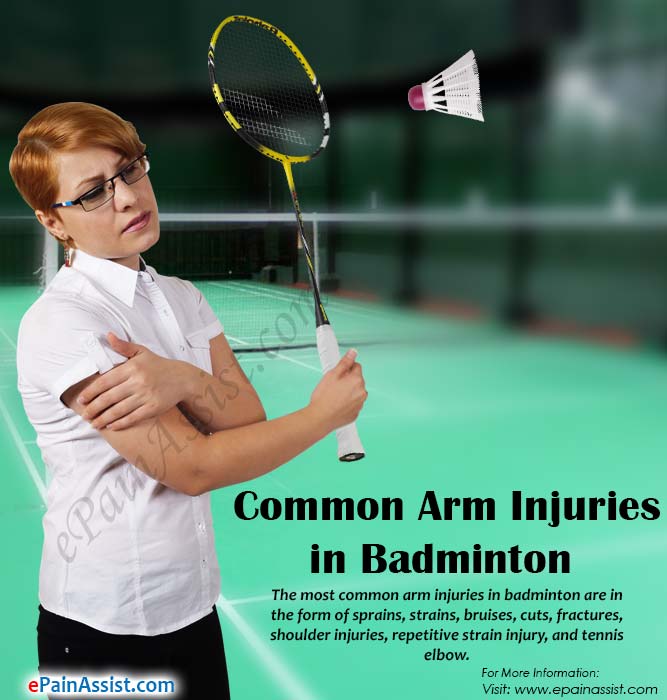Badminton is one of the most popular indoor sports across the world and is slowly gaining recognition in countries where other major sports prevail. The body parts that are majorly involved in playing badminton are the scapular region, upper limbs, upper arm, forearm, abdomen and back, thighs, calves, ankles and heels. Badminton is an all body sport and requires a lot of physical stamina and strength for jumping, lunging, quick changes in directions and rapid arm movements from a variety of postural positions. Due to this, the players sustain injuries primarily in their limbs. These injuries are often severe, but occur less frequently. The most common arm injuries in badminton are in the form of sprains, strains, bruises, cuts, fractures, shoulder injuries, repetitive strain injury and tennis elbow.[1]
What are the Body Parts and the Anatomy involved in Playing Badminton?
At competitive levels of badminton, the players require a great deal of cardiovascular conditioning, lower body and muscular endurance. Core strength and endurance are the two important factors that balance out and improve agility. Playing badminton requires the use of following major muscles:
- Muscles of the forearm and the upper arm (the wrist flexors and extensors, the biceps and the triceps) are the primarily used arm muscles while playing badminton.
- Muscles of the shoulder girdle (the latissimus dorsi, the teres major, the pectorals and the deltoids).
- Muscles of the lower leg (the gastrocnemius, the soleus and the anterior tibialis).
- Muscles of the upper legs and hips (the gluteals, the hamstrings and the quadriceps)
- Muscles of the hip (the gluteals, the adductors and abductors, and the hip flexor)
- The corer muscles (the rectus abdominus, obliques and the spinal erectors)

Common Arm Injuries in Badminton
The most common arm injuries that a person can suffer while playing badminton are as follows:
Tennis Elbow-A Common Arm Injury in Badminton:[2]
- Causes: The most common cause of tennis elbow is overuse of muscles around the elbow or the wrist due to repeated extension or bending back of the joints against resistance while playing badminton. In badminton, one of the reasons for tennis elbow to occur is poor back hand technique.
- Symptoms:
- Pain about 1-2 cm down from the bony part of the outside of the elbow
- Weakness in the muscles surrounding the elbow or in the forearm and wrist
- Difficulty in performing simple tasks that involve movement of the wrist or the elbow.
- Treatment:
- Applying ice or cold therapy is one of the best treatment for this badminton arm injury
- Physiotherapy or stretching exercises
- Wearing tennis elbow brace for support that helps reduce the strain
- Painkillers such as Ibuprofen can be used to reduce pain
- Sometimes, acupuncture, injections of corticosteroids, botox and autologous blood injections can be taken when prescribed by reliable sources.
Golfer’s Elbow:[3]
- Causes: This condition is caused by repeated flexion of the wrist and throwing actions while playing badminton as well as through intense manual jobs.
- Symptoms:
- Pain and tenderness in the bony section on the inside of the elbow is the common symptom of this arm injury sustained while playing badminton.
- Weakness in the wrist
- Pain in the wrist while bending it
- Treatment:
- Protection, rest, ice, compression, elevation when the injury is actually painful
- Cold and compression therapy
- Rehabilitation program and physiotherapy
- Rest
- Electrotherapy such as ultrasound or laser treatment to reduce pain and inflammation
- Anti-inflammatory medicine
- Sports massage or cross friction massage.
Repetitive Strain Injury:
- Causes: The condition is caused by repetitive movements of the wrist or fingers, working too fast, not having enough recovery breaks, holding the muscle in the same position for a very long time and working in cold conditions.
- Symptoms:
- Aching and burning pain
- Clumsiness, numbness and tremors
- Fatigue or loss of strength
- Weakness in the forearms
- Difficulty in performing simplest of tasks
- Chronically cold finger tips
- Treatment:
- Acupuncture and dry needling
- Sub-acute soft tissue injury treatment
- Scapular stabilization exercises
- Supportive taping & strapping
- Soft tissue massage
- Brace or support
- Heat packs
- Electrotherapy & local modalities
- Joint mobilization techniques
- Neurodynamics
- Physiotherapy instrument mobilization (PIM)
- Proprioception & balance exercises
- Strength and stretching exercises
- Prehabilitation
- Yoga.
Preventing Arm Injuries in Badminton[5]
Both acute as well as chronic arm injuries from badminton can be prevented by using right kind of equipments, exercises, warming up, cooling down and ensuring the body is fit enough to compete. A good warm up generally increases the temperature of the muscles and increases the blood and oxygen flow to the muscles. It not only helps to avoid arm injuries in badminton but also reduces the risk of wear and tear. Cooling down lowers the heart rate and restores the blood and oxygen supply to the muscles. It also helps remove waste products such as lactic acid and reduces soreness. Getting a good and regular sports massage flushes out the waste products, releases the knots, lumps and bumps in the muscles that may cause strains if left untreated. Proper nutrition and hydration also prevents sudden wear and tears as well as exhaustion. Aerobic fitness, general condition, and muscular strength are important in order to reduce the risk of injuries. A good all rounding conditioning helps to balance the body and avoid unnecessary injuries.
